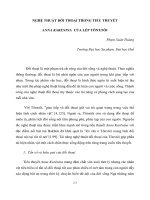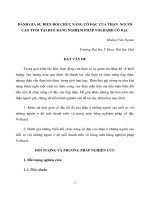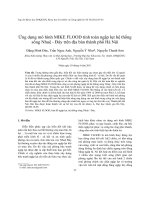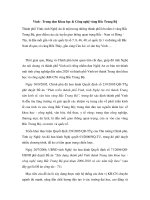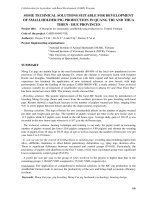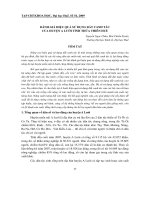Báo cáo nghiên cứu khoa học: "nhiễm trùng đường hô hấp cấp tính trẻ em của trường mầm non tại thành phố Huế" doc
Bạn đang xem bản rút gọn của tài liệu. Xem và tải ngay bản đầy đủ của tài liệu tại đây (159.02 KB, 7 trang )
333
JOURNAL OF SCIENCE, Hue University, N
0
61, 2010
ACUTE RESPIRATORY INFECTIONS
IN CHILDREN OF PRE- SCHOOLS IN HUE CITY
Dang Nhu Phon, Nguyen Van Tap
College of Medicine and Pharmacy, Hue University
SUMMARY
Acute respiratory infection (ARI) is a common disease and is the highest cause of death
in children under 5 years of age in many countries. In Vietnam, the program to prevent acute
respiratory infection started in 1984, and aims to reduce the rate of acute respiratory infections
in children, and reduce mortality caused by this disease. However, acute respiratory infections
still attract much concern because the incidence of the disease is still high and affect the health
of children. This study aims to identify the prevalence of acute respiratory infections in children
attending nusery schools in Hue city. A cross-sectional survey of 398 children attending nursery
schools in Hue city was conducted. Through research, we got the following results: (1) the
prevalence of acute respiratory infections within two weeks of the survey was 22.36%, (2) the
prevalence of acute respiratory infections increased with age, (3) the prevalence of acute
respiratory infections did not differ by gender.
1. Introduction
Acute respiratory infections (ARI) are a common disease and causes high
mortality for children under 5 years old in many countries. According to a study by
Wajula (1991), the incidence of ARI/ total number of children in Iraq is 39.3%, in Brazil
is 41.8%, in the UK is 30.5%, and in Australia is 34%.
The World Health Organization (WHO) states that every year approximately 15
million children die, of which about 5 million die from ARI. In Vietnam, ARI in
children leads to mobidity and mortality. ARI contains 44% of common diseases. In the
community, the ARI program (1997) indicated that a village with a population of 8000,
children under 5 years old spent 1600-1800 times having ARIs each year, of which
about 400-450 times children have pneumonia required the treatment. A program to
prevent acute respiratory infection started in 1984, which aims to reduce the prevalence
of acute respiratory infections in children and reduce mortality caused by this disease.
However, currently ARI has attracted much attention because the incidence of
334
the disease is still high and affects the health of children. This study aims to identify the
prevalence of acute respiratory infections in pre-school children in Hue city and the
distribution of the disease by age and gender.
2. Subjects and method
2.1. Research subjects: children in nursery schools in Hue city.
2.2. Research Methodology
2.2.1. Study Design: cross-sectional study with random sampling
2.2.2 Sample size: from the formula for calculating the sample size, 398 children
aged 2 to under 6 years old were selected
2.2.3. Data collection techniques
- Criteria for determination of ARI when accompanied by fever and one of the
following symptoms: cough, shortness of breath, concave chest on withdrawl, runny
nose, sore throat. A child was determined not to have an ARI if the criteria are not
satisfied.
- Age was determined according to the WHO classification and divided into 04 groups:
2 to under 3 years old; 3 to under 4 years old; 4 to under 5 years old and 5 to under 6
years old.
2.2.4. Data collection method: A questionnaire was used to gather the variables.
Questions about variables with disease or without disease was collected by maternal
recall within 2 weeks of the survey.
2.2.5. Data analysis: software SPSS 11.5
3. Results
3.1. Characteristics of the study sample
Table 3.1. Distribution of age groups by gender
Ages Male Female p Total
2 - < 4 ages 28 (14.36%) 29 (14.08%)
>0.05
57 (14.32%)
4 - < 5ages 61 (31.77%) 63 (30.58%) 124 (31.16%)
5 - < 6 ages 103 (53.65%) 114 (55.34%) 217 (54.52%)
Total 192 206 398
Reviews: ratio of gender among different age groups is not statistically
significant (p> 0.05).
335
3.2. The situation of acute respiratory infections
Table 3.2. The situation of acute respiratory infections in the study sample.
Status Frequency (n) Rate (%) p
ARI 89 22.36%
<0.01
Not ARI 309 77.64%
Total 398 100%
Reviews: Surveys 398 children, 89 children met the criteria for ARI within the
past two weeks with a rate of 22.36% (95% confidence interval)
22,36%
77,64%
ARI Not ARI
Chart 3.1. The situation of acute respiratory infections in the study sample
Table 3.3. The situation of acute respiratory infections by age group distribution
Age group
distribution
ARI Not ARI p Total
2 - < 4 ages 22 (11.64%) 35 (11.32%)
<0.01
57 (14.32%)
4 - < 5 ages 32 (22.88%) 92 (22.77%) 124 (31.16%)
5 - < 6 ages 35 (65.48%) 182 (58.91%) 217 (54.52%)
Total 89 309 398
Reviews: Group 5 to under 6 years old has rate of ARI (65.48%) higher than the
rest. This difference is statistically significant with p <0.01.
336
Table 3.4. The situation of ARI according to gender distribution
Gender ARI Not.ARI p Total
Male 46 (51.69%) 146 (47.25%)
> 0.05
192 (48.24%)
Female 43 (48.31%) 163 (52.75%) 206 (51.76%)
Total 89 309 398
Reviews: The rate of ARI in male is 48.24%, and 51.76% in female, but this
difference is not statistically significant with p<0,05.
51.69
48.31
47.25
52.75
44
45
46
47
48
49
50
51
52
53
ARI Not ARI
Male
Female
Chart 3.3. The situation of acute respiratory infections by gender distribution
4. Discussion
4.1. Prevalence of common acute respiratory infections
The research results acquired by (table 3.3.) surveying 398 children under 6
years of age found 89 children suffered from ARI within the past 2 weeks (proportion
of 22.36%). This is prevalence of the disease, according to Dinh Thanh Hue:
"describing the health phenomenon of a population at a certain time."
The author Nguyen Co Viet and colleagues investigated the three provinces of
Ha Nam, Da Nang, Tay Ninh and observed an ARI prevalence is 22.8%.
According to Bui Duc Duong, Nguyen Duc Chinh ARI prevalence was 24.4%.
According to other authors, ARI is the highest rate of infection compared with other
diseases. The rate of ARI (22.36%) is similar to these authors but lower than the rate
found in the studies of Nguyen Thi Man at 37.94% , and Nguyen Huy Binh at 38.67%.
On the other hand, a study of Nguyen Tan Vien, Le Thi Ngoc Viet said that the younger
children are, the higher ARI proportion is. In 0-12 month children, 54.90% had ARI,
This rate in children of 13-36 months was 33.28% and 11.28% for children of 37-60
months. The participants of our study were older, aged from 2 to under 6 years and the
investigation was carried out after a flood and change of season in Hue city , These
Rate %
337
reasons made ARI easy to catch and develop in Hue at this time. This is relevant with
the comments of the authors Ta Thi Anh Hoa, Nguyen Dinh Huong, Nguyen Tan Vien.
4.2. Acute respiratory infections by age group
Table 3.1. Showed that 5- under 6 years of age group got the highest ARI
accounting for 65.48%, 4 - under 5 years of age group accounting for 22.88% and
under 4 years of age accounting for 11.64%. The difference is statistically significant
with p <0.05.
This result shows that in older children, the rate of ARI is higher. This is in
contrast to study of other authors.
Research by Nguyen Tan Vien, Le Thi Ngoc Viet through 8084 for children of 5
years showed that ARI prevalence of children 2-12 months was 54.90%, 13-36 months
at 33.28% and 37-60 months at 11.82%.
According To Anh Toan, Bui Duc Duong (2004), ARI in under 1 year old
children was two times as high as that in 3 age groups, and 2,5 times as high as that in
4 age group.
The smaller the age is, the higher the rate of ARI is. According to Le Thi Nga
and colleagues (1998) children aged 0-12 months have the highest ARI proportion at
62.9%.
However in our study, the participants were children in pre-schools. There are
more older children who go to school than younger ones. The younger children tend to
stay at home or in hospital for care when they are ill, they do not go to school, so we
could not join the list of them in our investigation. For older children when they get
mild sickness, they may continue schooling and thus remained on the books of the
investigation. The proportion of children in the study is 2 – under 4 years of age is 57
(14.32%), 4 - 5 years old was 124 (31.16%) and 5 to under 6 years of age is 124
(31.16%), so in our study, the older children have a higher ARI rate.
Acute respiratory infections according to gender distribution Table 3.4 showed
that the rate of males is 48.24% of whom 51.69% are infected with ARI. The proportion
of females is 51.76%, of whom 48.31% are infected ARI. Results showed that the ARI
rate in males is higher than that in females, however, this difference is not statistically
significant (p> 0.05).
Nguyen Co Viet and colleagues estimated an ARI prevalence of which males
account for 53.1% and females 46.9%. This rate has no statistical differences between
males and females, which was also the case in the studies of Bui Duc Duong, Nguyen
Duc Chinh.
338
5. Conclusions
From the results obtained in this study, we reached the following conclusions:
The prevalence of acute respiratory infections within two weeks of the
survey was 22.36%
The prevalence of acute respiratory infections increased with age.
The prevalence of acute respiratory infections did not differ by gender.
REFERENCES
1. Bộ Y Tế, “ Chương trình nhiểm khuẩn hô hấp cấp tính ở trẻ em”, Đánh giá, phân loại
và xử trí Nhiễm khuẩn hô hấp cấp trẻ em, Hà Nội, (1994), 28-38.
2. Bùi Đức Dương, Nguyễn Đức Chính, Tình hình sử dụng dịch vụ y tế cơ sở và khả năng
tiếp cận của trẻ em với chương trình NKHHC, Hội nghị khoa học về lao và bệnh phổi,
Bộ Y Tế, (2001), 103- 104.
3. Lê Thị Nga và cộng sự, Tình hình mắc bệnh Nhiễm khuẩn cấp ở trẻ em dân tộc Sán
Dìu và Mông ở Thái Nguyên – Hà Giang”, Hội nghị tổng kết hoạt động ARI , Bộ Y Tế ,
Hà Nội, (1998).
4. Nguyễn Huy Bính, Nghiên cứu tình hình nhiễm khuẩn hô hấp cấp ở trẻ em dưới 5 tuổi
tại phường Vĩnh Hải, thành phố Nha Trang, tỉnh Khánh Hòa. Luận văn tốt nghiệp
chuyên khoa I chuyên ngành y tế công cộng, (2007), 33-34
5. Nguyễn Tấn Viên, Lê Thị Ngọc Việt, Một số nhận xét về bệnh NKHHCT ở trẻ dưới 5
tuổi qua 5.084 trường hợp NKHHCT ở trẻ 2 tháng đến 5 tuổi, Kỷ yếu công trình Nhi
khoa, (1994), 358-363.
6. Nguyễn Thị Măn, Nghiên cứu tình hình nhiễm khuẩn hô hấp cấp ở trẻ em dưới 5 tuổi
tại phường Thống Nhất, thành phố Biên Hòa, tỉnh Đồng Nai, Luận văn tốt nghiệp
chuyên khoa I chuyên ngành y tế công cộng, (2008), 38.
7. Nguyễn Việt Cồ, Bùi Đức Dương, Tình hình sử dụng dịch vụ y tế cơ sở và khả năng tiếp
cận của trẻ em với chương trình NKHHCT, Hội nghị tổng kết hoạt động ARI, Hà Nội,
(2000), 38.
8. Tạ Thị Ánh Hoa, Chương trình Quốc gia phòng chống nhiễm khuẩn hô cấp ở trẻ em,
Bài giảng nhi khoa tập 1- Trường Đại học Y Dược Thành phố Hồ Chí Minh, (1997),
484- 486.
9. Dhamage.SC, Rajapaksa.LC, Fernando.DN, Risk factors of acute lowers respiratory
tract infections in children under five year of age, Southeast Asian J Trop Med Public
339
Heath, 27 (1), (1996), 107-10.
10. Sow O,Diallo AB, Acute respiratory infections in children: a community based study
comparing a primary healthcenter and a pediatric unit, Republic of Gunnea, Tuber
Lung Dis, (1995), 4-10.
